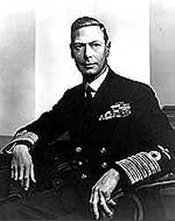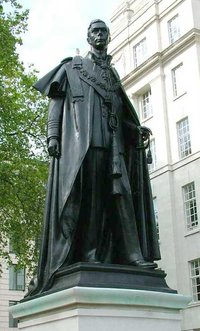George VI of the United Kingdom
|
|
 King George VI King of the United Kingdom (1936-52), King of Ireland (1936-1949), Emperor of India (1936-1947) |
George VI (Albert Frederick Arthur George Windsor, formerly Wettin) (December 14, 1895–February 6, 1952) was the third British monarch of the House of Windsor, reigning from December 11, 1936 to February 6, 1952. As well as being the King of the United Kingdom of Great Britain and Northern Ireland and the British dominions beyond the seas, George VI was the last Emperor of India (until 1947), the last King of Ireland (until 1949) and the last King of Pakistan (until 1952).
George VI succeeded the throne unexpectedly after the abdication of his brother, King Edward VIII. He was most famous for his role in World War II as a symbolic leader for the British Empire's fight against Nazi Germany.
| Contents |
Early life
George VI was born on 14 December, 1895 at York Cottage, on the Sandringham Estate, Norfolk.
His father was Prince George, Duke of York (later King George V), the second eldest son of Edward VII and Alexandra of Denmark. His mother was Her Royal Highness The Duchess of York (later Queen Mary), the eldest daughter of Prince Francis, Duke of Teck and Princess Mary Adelaide of Cambridge.
His paternal grandfather was still the Prince of Wales at the time of his birth. His eldest son, Prince Albert Victor, Duke of Clarence, had been second in line for the throne. However the elder Prince reportedly died of pneumonia on 14 January, 1892. The Duke of York replaced him as second in line for the throne.
On June 23, 1894, the Duke and Duchess of York had their first son Edward who was third in line for the throne. The future George VI was thus fourth in line for the throne since birth. As a great grandson of Queen Victoria and the deceased Prince Albert of Saxe-Coburg and Gotha in the male line, he was styled His Highness Prince Albert of York from his birth.
In 1898, Queen Victoria passed letters patent which granted the children of the eldest son of the Prince of Wales, the style Royal Highness. Thus Albert was then styled His Royal Highness Prince Albert of York.
As a child, Albert often suffered from ill health. His parents, the Duke and Duchess of York, were often removed from their children's upbringing. Unfortunately this allowed the Royal nanny to have a dominating role in their young lives. The nanny doted over Albert's brother, Prince Edward while neglecting Albert. Albert developed a severe stammer that lasted for many years. He was also forced to write with his right hand although he was a natural left-hander. While it is not known if left-handedness is genetic, many members of the British Royal Family have been left-handed.
Queen Victoria died on 22 January, 1901. The Prince of Wales succeeded her as King Edward VII. The Duke of York became the new Prince of Wales. Prince Edward was then second in line for the throne. Prince Albert was third in line.
Military career
In 1909, Albert joined the Royal Navy and served as a naval cadet. Despite coming bottom of the class, Albert moved to Dartmouth and served as a midshipman. He was still in the Navy when Edward VII died on 6 May, 1910. His father became King George V. Prince Edward was created Prince of Wales on 2 June, 1910. Albert was second in line for the throne.
Albert served during World War I (1914 - 1918). He saw action aboard HMS Collingwood in the Battle of Jutland (31 May - 1 June, 1916). The battle was a tactical victory for the German Empire but a strategic victory for the United Kingdom of Great Britain and Ireland.
In 1917, Albert joined the Royal Air Force but did not see any further action in the war.
In 1920, Prince Albert was created Duke of York, Earl of Inverness and Baron Killarney. He then began to take on royal duties, representing his father, King George V.
Marriage
Albert had a great deal of freedom in choosing a prospective wife. He married Lady Elizabeth Bowes-Lyon, the youngest daughter of the Earl and Countess of Strathmore on April 26, 1923 in Westminster Abbey. The newly-formed BBC wished to record and broadcast the event on radio, but the Archbishop of Canterbury Randall Thomas Davidson, vetoed the idea because "men in public houses may listen to the ceremony with their hats on". Lady Elizabeth was styled Her Royal Highness The Duchess of York after their marriage.
The Duke and Duchess of York had two children:
- Elizabeth II (born April 21, 1926)
- Princess Margaret (August 21, 1930 - February 9, 2002).
Reluctant king
Coronation_of_King_George_VI.jpg
The Duke and Duchess lived a relatively sheltered life at their London residence, 145 Piccadilly. On January 20, 1936, King George V died and Prince Edward ascended the throne as Edward VIII. As he had no children, Albert was now the heir presumptive to the throne until the unmarried Edward VIII had any legitimate children. However, Edward VIII abdicated the throne on December 11, 1936, in order to marry his love, Wallis Warfield Simpson. Thus Albert was now king, a position he was reluctant to accept. It is said that he wept for hours on the shoulder of Queen Mary when told the news.
Despite his reluctance, Albert was now king and chose to take the name George to become King George VI. His decision not to rule as King Albert was partly to follow King Edward VII precedent of not taking the name Albert, and also to follow his father's name and restore confidence in the monarchy. Occasionally a legend has been put about that Queen Victoria wished no British king to take the name Albert, but this is quite unfounded.
George VI's coronation took place on May 12, 1937—the intended date of Edward's coronation. In a break with tradition, Queen Mary attended the coronation as a show of support for her son. There was no durbar held in Delhi for George VI, as had occurred for his father, as a prolonged absence from Britain in the tense period before World War II would have been unthinkable.
Reign
The beginning of George VI's reign was taken up by the questions surrounding the ex-King Edward VIII. George VI decided to create his brother, now reverted to his previous title of Prince Edward, as the Duke of Windsor. He also issued letters patent entitling Prince Edward to be styled His Royal Highness, but preventing any wife and children from being so. George VI was also forced to buy the royal homes of Balmoral Castle and Sandringham House from Prince Edward, as these were private properties and did not pass to George VI on his accession.
The growing likelihood of war erupting in Europe would dominate the reign of King George VI. Initially the King and Queen took an appeasement stance against Hitler, supporting the policy of Neville Chamberlain. The King and Queen greeted Chamberlain on his return from negotiating the Munich Agreement in 1938, and invited him to appear on the balcony of Buckingham Palace with them, sparking anger among anti-appeasement MPs including Winston Churchill.
In 1939, the King and Queen visited Canada and the United States of America, the first reigning monarchs to do so. The aim of these visits was mainly political, to shore up Atlantic support for Britain in any upcoming war. The King and Queen were warmly received by the American people and stayed at the White House with President Franklin D. Roosevelt.
When war broke out in 1939, George VI with Queen Elizabeth resolved to stay in London and not flee to Canada, as had been suggested. The King and Queen officially stayed in Buckingham Palace throughout the war, although they often escaped to Windsor Castle to avoid bombing raids. George VI and Queen Elizabeth narrowly avoided death when a lone German bomber despatched to bomb Buckingham Palace attacked. The bomb exploded in the courtyard, shattering windows in the palace.
Throughout the war, the King and Queen provided morale-boosting visits throughout the UK, visiting bomb sites and munition factories. On VE Day, the Royal Family appeared on the balcony of Buckingham Palace to celebrate the end of the war in Europe.
Illness
The war had taken its toll on the King's health. This was exacerbated by his heavy smoking and subsequent development of lung cancer. Increasingly Princess Elizabeth, his daughter and heir presumptive to the Throne, would take on more of the royal duties as her father's health deteriorated.
On February 6 1952, George VI died at Sandringham House in Norfolk. His funeral took place on February 15, and he was buried in St George's Chapel in Windsor Castle. In 2002, the remains of his wife Elizabeth and his daughter Princess Margaret were interred in a tomb alongside him.
Empire to Commonwealth
George VI's reign saw the beginning of the decline of the British Empire, which greatly accelerated after the ending of World War II. Firstly, India became an independent dominion, leading George VI to relinquish the title of Emperor of India. He served as King of India until a republic was declared in 1950.
He was also the last King of Ireland, succeeding to that title by the adoption of the External Relations Act until its repeal in the Republic of Ireland Act in 1948.
The decision of India in 1950 to become a republic saw it recognise George VI as Head of the Commonwealth, a title now incorporated into the regal style, although it is not clear whether the title is hereditary.
Legacy
A statue of George VI adorns The Mall, near Admiralty Arch.
A biographical television series, Bertie and Elizabeth, was broadcast on BBC in 2003. The series was also broadcast on PBS as a part of the Masterpiece Theater series in March 2005.
Titles from birth to death
- 1895-1898: His Highness Prince Albert of York
- 1898-1901: His Royal Highness Prince Albert of York
- 1901: His Royal Highness Prince Albert of Cornwall and York
- 1901-1910: His Royal Highness Prince Albert of Wales
- 1910-1920: His Royal Highness The Prince Albert
- 1920-1936: His Royal Highness The Duke of York
- 1936-1947: His Majesty George VI, by the Grace of God, of Great Britain, Ireland, and of the British dominions beyond the seas, King, Defender of the Faith, Emperor of India.
- 1947-1952: His Majesty George VI, by the Grace of God, of Great Britain, Ireland, and of the British dominions beyond the seas, King, Defender of the Faith.
External link
- Titles, Orders, and Military Appointments (http://www.regiments.org/milhist/biography/royals/1895geo6.htm)


